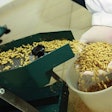If your firm has used fumigants, you’re no stranger to fumigation management plans (FMP). A FMP is a written record providing specific logistical, performance, and contact information to help "characterize" the fumigation of a commodity storage site. Designed to ensure legal and effective fumigation, FMPs ensure the safety of the applicators, the storage facility employees, the surrounding community, and the environment. Consequently, FMPs must be enforced from within each organization providing the fumigation… and the industry’s fumigant supplier’s work diligently to educate their clients.
In conjunction with other steps in an integrated pest management (IPM) program, fumigants are essential in fighting pests from a practical application standpoint.
“Fumigants must be used with due respect,” Morgan says. “They’re only dangerous when misused, and therein lies the value of a handling plan.”
FMPs are enforced by the local, state and federal governments, but stressing the importance of fumigant safety remains a high-priority issue to suppliers and companies alike. Companies using fumigants should regularly schedule employee safety meetings and send representatives to attend the training classes offered by industry groups or state regulators.
Jim Smiley notes that compliance is not voluntary, it’s mandatory: “Employees who fail to comply with the required written Fumigation Management Plan provisions of the complete label are subject to criminal and/or civil penalties.”
“Enforcement falls on the state regulatory agency, however the company needs to prepare the fumigation management plan per the fumigant label/manual and keep it on file, follow it and modify it as needed,” Morgan says.
According to the EPA’s guidelines, management needs to ensure compliance with those performing the fumigation by making it a requirement, first through personnel training and notification prior to fumigation, during and after the application:
- Confirm in writing that all personnel in and around the structure and/or area to be fumigated have been notified prior to application of the fumigant. Consider using a checklist that each employee initials indicating they have been notified.
- Instruct all fumigation personnel to read the Applicator’s Manual concerning the hazards that may be encountered and the selection of personal protection devices, including detection equipment.
- Confirm that all personnel are aware of and know how to proceed in case of an emergency situation.
- Instruct all personnel on how to report any accident and/or incidents related to fumigant exposure. Provide a telephone number for emergency response reporting.
- Establish a meeting area for all personnel in case of an emergency.
Things to consider
When thinking about your fumigation management plan, don’t lose sight of regularly following up on these internal check and balances.
#1 Proper licensing and certified for use of the product
Federal law classifies all fumigants as “Restricted Use Pesticides,” and each state has its own requirements and provisions for licensing and certification, and applicants must pass an examination to demonstrate competence in the use of pesticides. Who provides it? Depending on the state, in accordance with national standards, the state department of agriculture, state chemist or state EPA is in charge of distributing applicator licensing.
The certified applicator is responsible for working with the owners and/or responsible employees of the site to be fumigated to develop and adhering to the FMP. Companies should keep one FMP on file for each type of fumigation done at the facility, e.g. spot fumigation of empty bins; fumigation of grain while loading; railcar fumigations, etc.
Some states require multiple licensed people within an organization, but most fumigant labels require one licensed person and one additional person trained in the use of the product, Morgan says. Also, depending on the capacity of the facility, additional certified persons may be recommended. All applicators must have knowledge of “General Standards of Competence” for all certification categories/regulations as required by each state.
Not only does the applicator need to be licensed, they need to read and follow label and manual directions for the fumigant being used, Martin points out.
“It is critical that all fumigators are aware and compliant to the regulations governing each product,” Boyer says. “This fumigation will become more governed and restricted in time, not less restrictive. Knowledge and understanding of these rules and regulations is key for effective performance, commodity condition, applicator and public safety, as well as the reputation of our industry.”
All fumigant manufacturers mandate stewardship training, and most offer online training opportunities for users.
#2 Personnel properly trained in the use of personnel protective equipment
Clothing, respiratory protection, eye protection — Personal Protection Equipment (PPE) is very specific to each product. It is important the applicator understands the specific labels and directions for use of each product they are applying. Requirements are spelled out in the complete label, and inspection must comply with OSHA regulations.
“Written certification of fit testing is required by OSHA regulation to be kept for all employees required to wear respirators, gas masks or SCBAs (Self Contained Breathing Apparatus),” Smiley explains.
A fit test consists of a medical evaluation followed by either a quantitative or qualitative test of the user’s ability to wear the required respiratory protective device.
Annual Respirator Fit Test Kits must comply with OSHA regulations, as OSHA spells out in the OSHA Standard 1910.134. This requires fit testing of all respirators including those with positive pressure. The respirator fit test is done to check that the mask size and mask model chosen fits the face. The fit test confirms that the mask fits the wearer’s face and that there is minimal air leakage between the face and the mask.
It is based on two types of fit testing: qualitative and quantitative:
- Qualitative is a pass/fail that relies on the respirator wearer’s indicating whether he/she can smell, taste, or sense the test agent; and
- Quantitative fit testing gives an objective measure of the quality of the seal between the wearer’s face and the facepiece. A fit factor number is produced.
It is best to have respirator manufacturers or your safety equipment supply vendor perform the training; most manufacturers will come to your location to help with fit testing.
#3 Up keep of clearing detection and monitoring equipment
The maintenance of clearing detection equipment ensures the health of employees, customers and the general public. Clearance refers to insuring fumigant concentrations in the commodity and the airspace around it are below the established TLV (Threshold Limit Value) for the fumigant being used; the limits are determined by the American Conference of Governmental Industrial Hygienists (ACGIH). Detectors look for minute concentrations of fumigants in the air; ensuring that the detection equipment is appropriate for the specific product being used.
“For safety purposes, it is considered essential to have detection equipment that will give reliable and immediate indication of toxic concentrations of fumigants,” Boyer explains.
Apart from the determination of full fumigant concentrations during actual exposure, much of the equipment may also be used to measure the success of the aeration process as indicated by the presence or absence of residual vapors. Some of the equipment may also be used for detecting leaks from the structure during treatment.
#4 Preparation of fumigant management plan
Creation of an FMP is spelled out in the complete label of the fumigant being used; consult the manual for the product being applied for a step-by-step guide.
According to Smiley: “Each state has the ability to set the requirements for fumigant use within its borders. An applicator should ‘consult with your state lead pesticide regulatory agency to determine regulatory status, requirements status, requirements and restrictions’ before creating a required written Fumigation Management Plan.”
Many examples of FMP are available on the Internet. All manufacturers stress that before any fumigation begins, the Label and the Applicator’s Manual are carefully read and reviewed. Each item on the FMP guide must be considered; however, each fumigate is different and not all items may be necessary.
“Fumigant manufacturers are very open to direct inquiries from applicators, usually via phone or email,” Morgan says. “When in doubt, the applicator should seek advice from their distributor (place they bought it) or the manufacturer.”


















